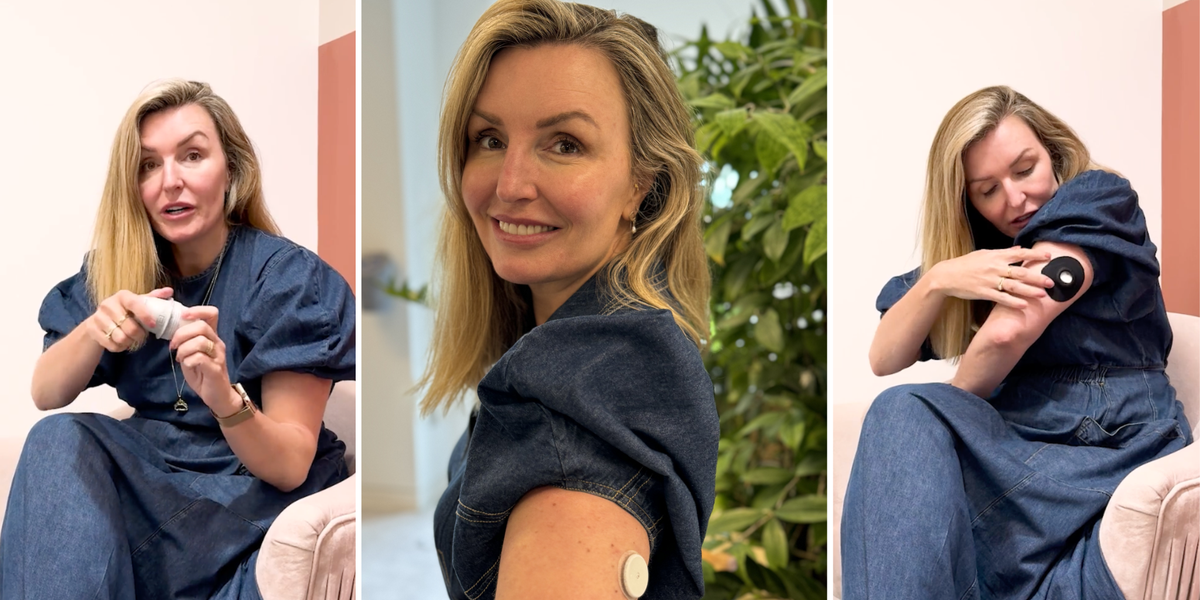
HOW TO WEAR AND PAIR A LINGO GLUCOSE MONITOR - AND HOW THE DATA CAN HELP SHAPE YOUR FUTURE
It would be disingenuous of me not to admit that one of the reasons I wanted to try Lingo was to lose weight. I turned 46 in June and in the last ten months or so, I’ve gained about 14Ibs.
There are multiple reasons for this that far outweigh simple gluttony or lack of control. Perimenopausal hormonal chaos, along with the stress of my mother dying, at the same time I took on a hugely demanding new job (I’m now the Editor-in-Chief of Men’s Health UK as well as Women’s Health UK) meant that my body was cortisol ridden, and consistent levels of high cortisol – the ‘stress hormone’ - can lead to increased appetite and weight gain.
During this time, I also trained for and ran the London Marathon. I’d been told weight gain while marathon training is very common, but I was convinced it would be the opposite for me. It wasn’t. More cortisol accumulated during those awful long runs, and then I was refuelling too much afterwards.
So, there I was approaching my 46th birthday overweight and unhappy. But weight loss isn’t the only reason I wanted to get into the glucose wearable game and join the masses at my swanky London gym who all seemed to be sporting the small circular device attached to their upper arms.
To say I didn’t luck out with the health gene pool is an understatement. Diabetes is rife in my extended family and my mother (and her father) both died of Alzheimer’s. The latter is the most appalling disease and something I’m terrified of, so I want to do all I can to reduce my chances of developing it. And there’s mounting research to suggest continuous high sugar levels is linked to more rapid cognitive decline, and particularly Alzheimer’s.
How to wear and pair a Lingo glucose monitor
Attaching the wearable is simple and pain-free, as is pairing it with the app on your phone. The app interface is easy to understand and navigate. At first, I didn’t change my usual meals but wearing the device immediately made me think twice about eating refined carbs and anything you’d find in the supermarket chocolate or biscuit aisle.
The first thing I learned is rice cakes are not my friend. Despite being relatively low calorie, they sent my blood sugar rocketing, way above the upper end of healthy which according to the app is 7.8 mmol/L. I also quickly learned that even when I’ve not eaten anything, stress - like when trying to get my to children out the door for school in the mornings - has a shocking impact on my glucose levels, again sending them shooting up. My recent weight gain was starting to make sense.
I started to experiment with food combinations. Eating fat with carbs deadens the spike, as does eating green vegetables first before the rest of the food on your plate. White potatoes are another food that drive my glucose up rapidly, but a glass of Champagne has hardly any effect at all.
I became hooked on checking the app. Each user is given a personalised number of daily maximum spikes, which you must try not to exceed. It also tells you what your average glucose measurement is each day, along with your glucose variability percentage – a measure of how much your glucose fluctuates from your baseline. High variability can lead to heart disease, diabetes and metabolic disfunction. Lingo suggests a healthy average glucose level is sub 6.5 mmol/L and healthy glucose variability is between 11% and 23%.
Avoiding refined sugar
When I began using Lingo at the end of April, my starting average glucose was 5.8 mmol/L (good) but my variability was 27% (not so good). My competitive nature soon kicked in and within a month my average glucose was consistently sub 5 mmol/L (as I’m writing this it’s 4.4 mmol/L) and my glucose variability hovers around 18% but often goes down to 14%. I’ve achieved this by being more mindful of what I’m eating and by actively avoiding refined sugar. My weight is starting to slowly decrease, even though I’m not tracking calories or even keeping a food diary.
But more important is the knowledge that I’m doing what I can to reduce my risk of following in my family members’ footsteps and developing diabetes and/or Alzheimer’s. Avoiding type 2 diabetes is a more exact science as the link between lifestyle and developing the disease is so clear. Alzheimer’s, on the other hand, is more complicated.
But I’m using everything in my arsenal – healthy eating, moving my body and now Lingo - to try to have an illness free future.
If you’re interested in tracking your glucose levels, first ask yourself why and if you really need to. We also recommend working with a medical professional or dietician to help you properly understand all the different insights into how your body responds to food and exercise.
More in Nutrition
- Thinking about staring the 5:2 diet? Here’s your need-to-know
- The egg diet is going viral, but it isn’t the health fix you might think it is
- Is the Atlantic diet the new Mediterranean diet?
Cut through the noise and get practical, expert advice, home workouts, easy nutrition and more direct to your inbox. Sign up to the WOMEN'S HEALTH NEWSLETTER
2024-07-17T09:03:28Z dg43tfdfdgfd